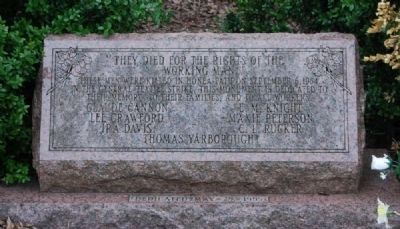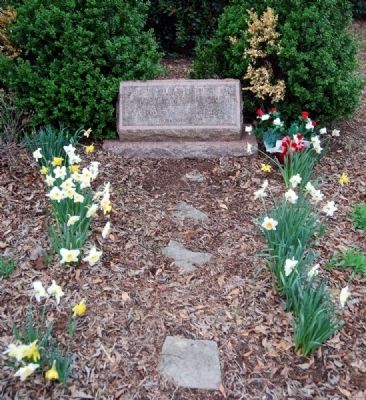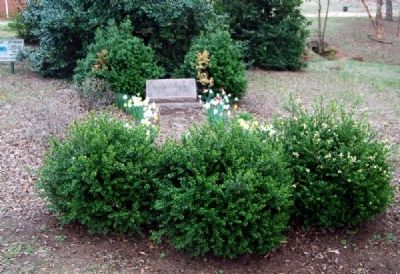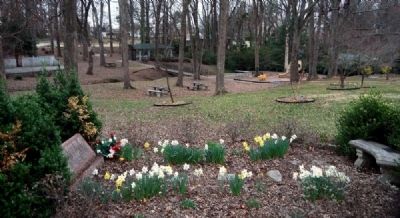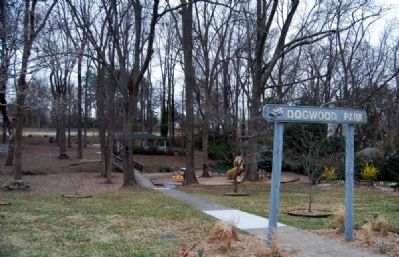Honea Path in Anderson County, South Carolina — The American South (South Atlantic)
They Died for the Rights of the Working Man
Claude Cannon, E.M. Knight
Lee Crawford, Maxie Peterson
Ira Davis, C.L. Rucker
Thomas Yarborough
Erected 1995.
Topics. This historical marker is listed in this topic list: Labor Unions. A significant historical month for this entry is September 1938.
Location. 34° 26.667′ N, 82° 23.633′ W. Marker is in Honea Path, South Carolina, in Anderson County. Marker is on Ervin Street, on the left when traveling west. Touch for map. Marker is in this post office area: Honea Path SC 29654, United States of America. Touch for directions.
Other nearby markers. At least 10 other markers are within 3 miles of this marker, measured as the crow flies. Honea Path Veterans Memorial (about 800 feet away, measured in a direct line); Panoramic Journey Through Honea Path (approx. 0.2 miles away); David Greer, Sr. (approx. 0.2 miles away); Carnegie Library (approx. ¼ mile away); Honea Path (approx. ¼ mile away); Chiquola Baptist Church Bell (approx. 0.4 miles away); The Story of the Bell (approx. 0.4 miles away); Chiquola Mill Monument (approx. half a mile away); Southside Baptist Church (approx. 1.4 miles away); James Kay House / Gentsville (approx. 2.6 miles away). Touch for a list and map of all markers in Honea Path.
Also see . . .
1. The shooting at Chiquola Mill became known as Bloody Thursday. Appalachian History website entry (Submitted on June 27, 2023, by Larry Gertner of New York, New York.)
2. Chiquola Mill Massacre. Wikipedia entry (Submitted on June 27, 2023, by Larry Gertner of New York, New York.)
Additional commentary.
1. Honea Path
The curiously double name of Honea (Ind., path) Path, 67.6 m. (810 alt., 2,740 pop.), was adopted when as many whites as Indians frequented this section. Another version is that Honea was the name of a family who lived there. At Honea Path in the late summer of 1934 occurred a mill riot that grew out of a Nation-wide textile strike. All South Carolina mills did not close on the zero hour, and "flying squadrons" of strikers and union sympathizers paid quick visits to mills that continued to operate. As a rule the squadrons were orderly, engaging in demonstrations to persuade the mill hands to strike; but minor injuries to their opponents kept them before the public eye. When arbitration failed, Governor Ibra C. Blackwood called out the National Guard. About 700 guardsmen were stationed in the Greenville area, and 600 citizens were deputized in Anderson to assist in preserving order. On September 6 a flying squadron visited Honea Path, to be met by a group of deputies and excited townsmen. Arguments grew into fist fights and gunplay, in which six strikers were slain and a seventh mortally wounded. At the same time a man was killed by a deputy in the Greenville area, and from Greenville and Pickens Counties came requests for the application of martial law. The governor issued a proclamation against flying squadrons, and the Honea Path Mill, for whose closing seven pickets had died on Thursday, opened the next Monday, protected by soldiers with machine guns. After the National Guard had been on duty for about a month, most of the strikers throughout the region decided to go back to work. (Source: South Carolina: A Guide to the Palmetto State by Federal Writers Project pg 420.)
— Submitted March 28, 2011, by Brian Scott of Anderson, South Carolina.
Credits. This page was last revised on June 27, 2023. It was originally submitted on March 28, 2011, by Brian Scott of Anderson, South Carolina. This page has been viewed 1,350 times since then and 68 times this year. Photos: 1, 2, 3, 4, 5. submitted on March 28, 2011, by Brian Scott of Anderson, South Carolina.
